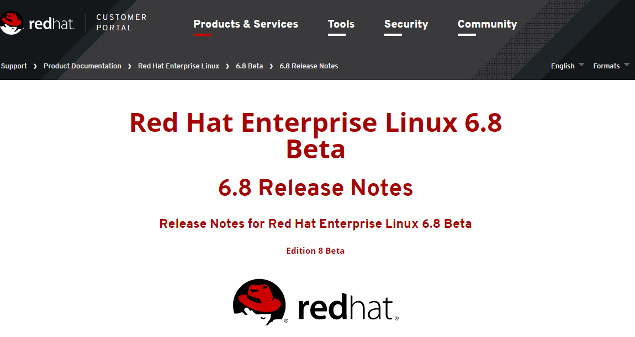The Release Notes provide high-level coverage of the improvements and additions that have been implemented in Red Hat Enterprise Linux 6.8 and document known problems in this release. For information about notable bug fixes, Technology Previews, deprecated functionality, and other details, refer to the Technical Notes. RED HAT ENTERPRISE LINUX. Red Hat® Enterprise Linux® is the leading open source alternative to proprietary operating systems. It's a reliable, modern IT platform that lets you deploy applications on physical hardware, in virtual machines, and in cloud environments. Red Hat Enterprise Linux 6.8 PAYG image comes with similar benefits as other Red Hat Enterprise Linux PAYG images in Azure Marketplace. If you’d like to utilize your existing Red Hat subscription to provision RHEL 6.8 VMs in Azure, you can do so through the Cloud Access program, and by following the Red Hat image preparation guidelines in. Oct 21, 2019 The latest version, Red Hat Enterprise Linux 6.8, provides both updated installation media for Red Hat. May 12, 2016 Red Hat Enterprise Linux 6.8 has landed. The latest version of the most popular server Linux, RHEL, is now ready to be deployed in your business.
Red Hat Enterprise Linux is the world’s leading enterprise Linux platform, now optimized for development.
With new developer-centric features like container tools, advanced language support, and application streams, Red Hat Enterprise Linux 8 (RHEL) is the most developer friendly Linux ever. Red Hat Developer members have full access to RHEL 8 software, documentation, and how-tos.
If you're familiar with Red Hat Enterprise Linux, then this is the place to get started.
Get started on RHEL 8
Red Hat Enterprise Linux 8 introduces new features that accelerate your application development including installation, coding, tool selection and setup. It includes dozens of runtime languages, compilers, databases, and web and cache servers.
Start with these commands below for your first time through.
For the impatient, use this yum syntax to install an Application Stream @modulename[:version]
Most recent version:
Or, install a specific version:
Use this if you want to see a list of what’s available:
For container development, RHEL 8 adds new Linux container tools: Buildah (container building), Podman (running containers) and Skopeo (sharing/finding containers). You can easily build images based on the many Application Streams.
For a quick reference to new RHEL 8 commands, download the Red Hat Enterprise Linux 8 Cheat Sheet for tips.
The most developer-friendly Linux ever.
Easy configuration for Windows users and Linux beginners.
RHEL 8 provides enhanced usability, as well as familiar, intuitive deployment and management features
Faster times to “Hello World” and real productivity.
Application Streams make a wide selection of open source tools, including languages, runtimes, databases, and web servers, ready to be installed with a single command. Through Application Streams, you can pick the version of tools you need for your project and easily switch if necessary.
Container development tools.
Expanded set of container development tools. RHEL 8 provides an easier transition to containerized workloads with new container tools such as Buildah, Podman, Skopeo, and CRI-O.
Convenience across RHEL versions and OpenShift.
Most open source programming languages, compilers, web tools, databases run on RHEL 7 and RHEL 8 and OpenShift.
How to know if your code is secure.
Red Hat Enterprise Linux a trusted platform for your business, and RHEL 8 continues to build on this tradition. Features like System Wide Encryption Policy, Nftables/firewalld, and Red Hat Insights mean less effort and time spent managing and configuring services, without compromising security needs.
Develop for containers with podman
Red Hat’s lightweight, open standards-based container toolkit is now fully supported and included with Red Hat Enterprise Linux 8. Built with enterprise IT security needs in mind, Buildah (container building), Podman (running containers), and Skopeo (sharing/finding containers) help developers find, run, build, and share containerized applications more quickly and efficiently, thanks to the distributed and daemonless nature of the tools.
RHEL 8 development tools

Red Hat Enterprise Linux 8 includes Application Streams of multiple versions of languages, compilers, databases, and other tools available - all are part of the subscription. The following components are currently available within RHEL 8:
Languages & compilers
- .NET Core 2.1
- Clang/LLVM Toolset 6.0
- GCC 8.2 (system compiler)
- Go Toolset 1.11
- Java 8 and 11
- Node.js 10
- Perl 5.26 and 5.24
- PHP 7.2
- Python 3.6 and 2.7
- Ruby 2.5
- Rust Toolset 1.31
- Scala 2.10
Databases, web tools, etc.
- MariaDB 10.3
- MySQL 8.0
- PostgreSQL 10.5 and 9.6
- Redis 5.0
- Apache httpd 2.4
- Nginx 1.14
For a complete list of packages available in the Appstream repo, type
Introducing CodeReady Builder
The RHEL 8 introduces a new repository, the CodeReady Linux Builder (or “Builder” for short) that developers may need while developing applications for RHEL. As you all know “developer” is not a one size fits all term.
Installation
Documentation

Because our code is open_
More from the world's enterprise open source leader
Trust us with your container technology
Forrester named Red Hat® OpenShift® as the leading platform for both developers and operators.
The future belongs to the flexible
With an open approach to working across clouds, you can adapt to inevitable change.
Develop and scale big ideas with Kubernetes
Let Red Hat® OpenShift® manage your cloud deployments so your developers can be more productive.
Mark your calendar for Red Hat Summit 2021
Next year’s Red Hat® Summit is expanding into an all-new, flexible, 3-part conference series to offer you more opportunities to tell your story.
Get all the detailsAll Red Hat products
Infrastructure
App dev
Fedora Linux
Digital transformation integrates new technology and applications into your existing infrastructure to fundamentally change how it operates.
The bank embraced digital transformation by building an app dev platform.
Integration
Topic
Understanding enterprise integration
Enterprise integration has evolved from a centralized model with an enterprise service bus (ESB) to a distributed architecture with many reusable endpoints.
Integrating apps and data on a private cloud let the bank launch innovative services.
Linux
Topic
Understanding Linux
Linux is the stable foundation for all IT workloads and deployments—whether traditional or innovative—from bare metal to virtual, cloud, and containers.
Suse Linux
Elo cut time to market with agile, on-demand infrastructure built on Red Hat Enterprise Linux.
Microservices
Topic
Understanding microservices
Microservices is an architecture and an approach to writing software where apps are broken down into their smallest components, independent from each other.
This bank used microservices to modernize its IT environment.
Middleware
Topic
Understanding middleware
Middleware is any software between the kernel and user applications that provides services to apps outside of what’s offered by the operating system.
Middleware helps the Dutch airport provide seamless journeys to customers.
Security
Topic
Understanding security
IT security protects the integrity of information technologies like computer systems, networks, and data from attack, damage, or unauthorized access.
The Argentine bank improved security with open source solutions.
Virtualization
Topic
Understanding virtualization
Virtualization makes a single physical machine act like multiple—saving you the cost of more servers and workstations.
Virtualization trimmed deployment times from weeks to hours for this provider.
Red Hat and open source
We believe in collaboration. We believe in choice, control, and freedom. Open source values like meritocracy, community building, and transparency are changing the way we approach business and life.
